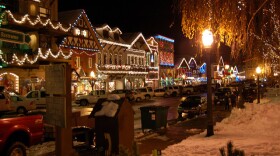Editor's note: This week on Going Places, KPLU travel expert Matthew Brumley sends a special guest in his place.
Some 53 million people live in Myanmar (or, if you’re looking at an older map, “Burma”), in big cities and small towns, in the mountains and on the coast. The government is loosening its economic controls, and that has resulted in an influx of foreign money spent by visitors traveling from Asia, Europe and, more and more, North America.
Jack Hurd is deputy director for the Asia-Pacific region of The Nature Conservancy. He’s lived in Thailand, Cambodia, and Vietnam, and traveled extensively throughout Asia over the last 25 years.
“Starting about 10 years ago, the government started issuing visas for independent tourism,” Hurd said. “You could go in and take a quick look around, and travel as a back packer to various places.”
For visitors, Myanmar has a variety of experiences. Luxury travelers will find elaborate hotels and resorts. Backpackers will find no shortage of hostels.
And everyone, Hurd says, will get a multi-cultural, multi-faceted experience.
Myanmar’s location, between the Indian subcontinent and the rest of Southeast Asia, makes it a crossroads of sort.
“It’s a primarily Buddhist country but there are Muslim populations, Christian populations,” Hurd said. “You see it play out in terms of the foods. A lot of curries come in from the subcontinent, and fresh fish and vegetables further in the south, and a Chinese influence in the north.”
Whatever culture influences a given town, you can expect it to be on display.
“So as you’re moving through towns, you see religious ceremonies that are happening on the backstreets in some of the other capital cities in Asia,” Hurd said.
One of his favorite places: Bagan, a city full of old temples.
“Bagan is in the central plains along the Iriwati River,” he said.
Stand on the western side of the town, along the Iriwati, and look east at dawn.
“What you see is the gradual lightening over hundreds of temples of different sizes and shapes and eras popping up off this plain,” Hurd said. “It’s quite a magical image.”
For Hurd, though, the beauty of travel in Yangon happens first upon arrival at the airport.
“You are automatically confronted with the rest of humanity,” he said. “You’ll see Chinese tourists, Indian businesswomen and men, European backpackers, American students, Fijian traders — the blending of people who show up and pass through a city like Yangon this year is not wholly dissimilar from what you would have seen 50 or 60 years ago, when Yangon was one of the capital cities of Asia.”
Getting There
It’s a 14½ hour time difference from Seattle. Fly to Japan, then to Bangkok, before hopping a flight to Yangon. It’s expensive to get there, but less so on the ground. Airfare starts around $1,500 for economy class seating.
---
Going Places is KPLU's travel segment, covering everything about getting from Point A to Point B. Each week, travel expert and Earthbound Expeditions founder Matthew Brumley offers advice on travel and tourism. This week, he hands the microphone over to Jack Hurd who talks about Myanmar.







